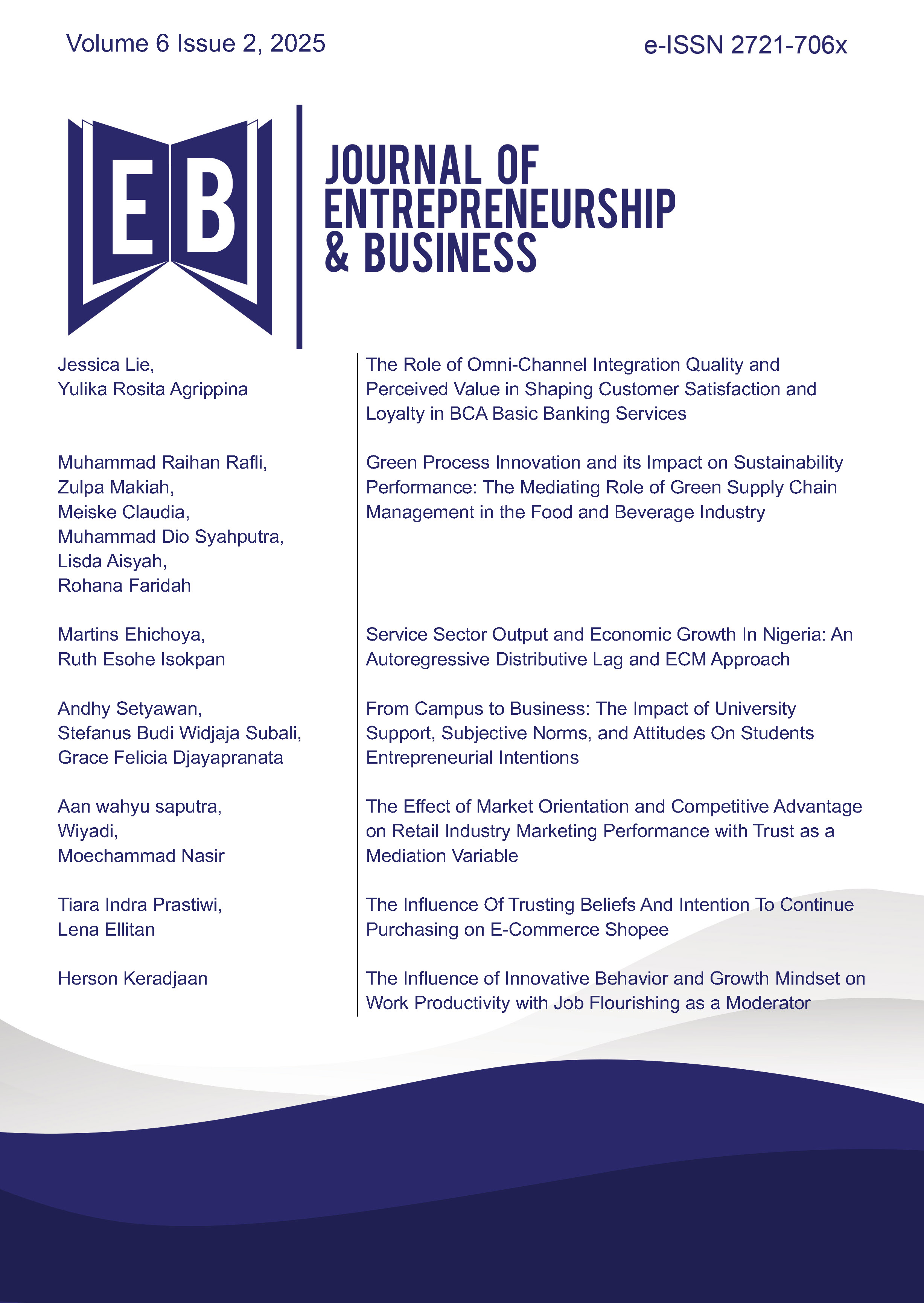The Influence Of Trusting Beliefs And Intention To Continue Purchasing on E-Commerce Shopee
 Abstract Views:
431 times
Abstract Views:
431 times
 PDF Downloads:
179 times
PDF Downloads:
179 times
Abstract
Purpose: This research aims to determine the influence of trusting beliefs and intentions on people to continue making purchases on Shopee e-commerce. As time progresses, there are more and more other digital platforms that can also make it easier for people to make purchases. However, this research specifically discusses whether the e-commerce platform can be trusted by old and new consumers through 5 variables, namely Competence, Integrity, Virtue, Purchase Intention, Purchase and Post Purchase.
Method: The sampling technique for this research is non-probability sampling with purposive sampling technique. The sample used in this research was 267 respondents with the criteria of being aged 17 years and over and who had purchased Scarlett Whitening products on Shopee e-commerce in the last 3 months.
Result: The findings of this study indicate that two hypotheses were not supported: the effect of integrity on purchase intentions, and the effect of integrity on purchases and post-purchase behavior through purchase intentions. In contrast, five hypotheses were supported. These include the effect of competence on purchase intentions, the effect of benevolence on purchase intentions, the effect of purchase intentions on purchases and post-purchase behavior, the effect of competence on purchases and post-purchase behavior through purchase intentions, and the effect of benevolence on purchases and post-purchase behavior through purchase intentions. Based on these findings, it is recommended that official Scarlett Whitening stores operating on the Shopee platform improve their consistency in serving both new and existing customers.
Downloads
References
Aditya, K. Y., & Wardana, I. M. (2017). Peran Brand Equity dalam Memediasi Pengaruh Word of Mouth Terhadap Niat Beli. E-Jurnal Manajemen Unud, 6(2), 830–856.
Agmeka, F., Wathoni, R. N., & Santoso, A. S. (2019). The influence of discount framing towards brand reputation and brand image on purchase intention and actual behaviour in e-commerce. Procedia Computer Science, 161, 851–858. doi:10.1016/j.procs.2019.11.192
Ahdiat, A. (2023). Pengunjung Shopee Makin Banyak, Bagaimana e-commerce lain?: Pusat Data Ekonomi Dan bisnis Indonesia: Databoks. Retrieved from https://databoks.katadata.co.id/teknologi-telekomunikasi/statistik/1fac6f15645c8fb/pengunjung-shopee-makin-banyak-bagaimana-e-commerce-lain
Alba, J., Lynch, J., Weitz, B., Janiszewski, C., Lutz, R., Sawyer, A., & Wood, S. (1997). Interactive home shopping: Consumer, retailer, and manufacturer incentives to participate in electronic marketplaces. Journal of Marketing, 61(3), 38–53. doi:10.1177/002224299706100303
Alzola, M., Hennig, A., & Romar, E. (2019). Thematic symposium editorial: Virtue ethics between East and West. Journal of Business Ethics, 165(2), 177–189. doi:10.1007/s10551-019-04317-2
Azwar, S. (2013). Metode Penelitian. Yogyakarta, ID: Pustaka Pelajar.
Bai, Y., Yao, Z., & Dou, Y.-F. (2015). Effect of social commerce factors on user purchase behavior: An empirical investigation from Renren.com. International Journal of Information Management, 35(5), 538–550. doi:10.1016/j.ijinfomgt.2015.04.011
Busalim, A. H., & Hussin, A. R. (2016). Understanding social commerce: A systematic literature review and directions for further research. International Journal of Information Management, 36(6), 1075–1088. doi:10.1016/j.ijinfomgt.2016.06.005
Chang, C.-C., & Tseng, A.-H. (2014). The post-purchase communication strategies for supporting online impulse buying. Computers in Human Behavior, 39, 393–403. doi:10.1016/j.chb.2014.05.035
Chin, W. W. (1998). The partial least squares approach to structural equation modeling. In G. A. Marcoulides (Ed.), Modern methods for business research (pp. 295-336). Mahwah, NJ: Lawrence Erlbaum Associates.
Dowell, D., Morrison, M., & Heffernan, T. (2015). The changing importance of Affective Trust and Cognitive Trust across the relationship lifecycle: A study of business-to-business relationships. Industrial Marketing Management, 44, 119–130. doi:10.1016/j.indmarman.2014.10.016
Engel, J. F., Blackwell, R. D., & Miniard, P. W. (2008). Perilaku Konsumen. Surabaya, ID: Binarupa Aksara.
Feola, G., Suzunaga, J., Soler, J., & Goodman, M. K. (2019). Ordinary land grabbing in peri-urban spaces: Land conflicts and governance in a small Colombian City. Geoforum, 105, 145–157. doi:10.1016/j.geoforum.2019.05.018
Ghozali, I. (2015). Aplikasi analisis multivariate Dengan program SPSS. Semarang, ID: Badan Penerbit Universitas Diponegoro.
Ghozali, I. (2016). Aplikasi Analisis Multivariete Dengan Program. IBM SPSS 23 . Semarang, ID: Badan Penerbit Universitas Diponegoro.
Hajli, N. (2015). Social Commerce Constructs and consumer’s intention to buy. International Journal of Information Management, 35(2), 183–191. doi:10.1016/j.ijinfomgt.2014.12.005
Hallikainen, H., & Laukkanen, T. (2018). National Culture and Consumer Trust in e-commerce. International Journal of Information Management, 38(1), 97–106. doi:10.1016/j.ijinfomgt.2017.07.002
Huberts, L. W. (2018). Integrity: What it is and why it is important. Public Integrity, 20(sup1). doi:10.1080/10999922.2018.1477404
Hwang, Y., & Lee, K. C. (2012). Investigating the moderating role of uncertainty avoidance cultural values on Multidimensional Online Trust. Information & Management, 49(3–4), 171–176. doi:10.1016/j.im.2012.02.003
Imantoro, F., Suharyono, S., & Sunarti, S. (2018). Pengaruh Citra Merek, Iklan, Dan Cita Rasa Terhadap Keputusan Pembelian (Survei Terhadap Konsumen Mi Instan Merek Indomie Di Wilayah Um Al- Hamam Riyadh) . Jurnal Administrasi Bisnis, 57(1), 180–187.
Kadarwati, K. (2019). Perilaku Organisasi: Pendukung Motivasi Karyawan Berkinerja Tinggi. Jakarta, ID: Raja Grafindo Perkasa.
Kim, S., & Park, H. (2013). Effects of various characteristics of social commerce (S-commerce) on consumers’ Trust and Trust Performance. International Journal of Information Management, 33(2), 318–332. doi:10.1016/j.ijinfomgt.2012.11.006
Lu, B., Fan, W., & Zhou, M. (2016). Social Presence, trust, and Social Commerce Purchase Intention: An empirical research. Computers in Human Behavior, 56, 225–237. doi:10.1016/j.chb.2015.11.057
McKnight, D. H., Choudhury, V., & Kacmar, C. (2002). Developing and validating trust measures for e-commerce: An integrative typology. Information Systems Research, 13(3), 334–359. doi:10.1287/isre.13.3.334.81
Molinillo, S., Anaya-Sánchez, R., & Liébana-Cabanillas, F. (2020). Analyzing the effect of social support and community factors on customer engagement and its impact on loyalty behaviors toward social commerce websites. Computers in Human Behavior, 108, 105980. doi:10.1016/j.chb.2019.04.004
Mulyadi, M. (2023). Sistem Akuntansi. Jakarta, ID: Salemba Empat.
Nurdin, I., & Hartati, S. (2019). Metodologi Penelitian Sosial. Surabaya, ID: Media Sahabat.
Ozer, L., & Gultekin, B. (2015). Pre- and post-purchase stage in impulse buying: The role of mood and satisfaction. Journal of Retailing and Consumer Services, 22, 71–76. doi:10.1016/j.jretconser.2014.10.004
Prakosa, D. M., & Imronudin, I. (2023). Analisis Pengaruh Brand Identity, Brand Image, Brand Integrity Dan Brand Interaction Terhadap Purchase Intention. (thesis).
Shi, X., & Liao, Z. (2017). Online consumer review and group-buying participation: The mediating effects of consumer beliefs. Telematics and Informatics, 34(5), 605–617. doi:10.1016/j.tele.2016.12.001
Sugiyono, S. (2017). Metode Penelitian Pendidikan Pendekatan Kuantitatif, Kualitatif dan R&D. Bandung, ID: Alfabeta.
Susilo, G. F., Rani, U., & Khotijah, S. A. (2022). The trusting beliefs of users and the intention to continue making purchases via Social Commerce. Journal of Indonesian Economy and Business, 37(1), 1–14. doi:10.22146/jieb.v37i1.1402
Svare, H., Gausdal, A. H., & Möllering, G. (2019). The function of ability, benevolence, and integrity-based trust in Innovation Networks. Industry and Innovation, 27(6), 585–604. doi:10.1080/13662716.2019.1632695
Syamsir, S., & Embi, M. A. (2020). Integrity Development through PSM for Corruption Prevention among Public Servant (First Author). International Journal of Psychosocial Rehabilitation, 24(8), 1437-1448.
Utomo, D., Setiawanta, Y., & Yulianto, A. (2011). Perpajakan: Aplikasi dan Terapan. Yogyakarta, ID: Andi.
Wang, W., & Benbasat, I. (2016). Empirical assessment of alternative designs for enhancing different types of trusting beliefs in online recommendation agents. Journal of Management Information Systems, 33(3), 744–775. doi:10.1080/07421222.2016.1243949
Wang, Y., & Yu, C. (2017). Social interaction-based consumer decision-making model in social commerce: The role of word of mouth and observational learning. International Journal of Information Management, 37(3), 179–189. doi:10.1016/j.ijinfomgt.2015.11.005
Xiao, M. (2019). Factors influencing esports viewership: An approach based on the theory of reasoned action. Communication & Sport, 8(1), 92–122. doi:10.1177/2167479518819482
Xu, J. (David), Cenfetelli, R. T., & Aquino, K. (2016). Do different kinds of trust matter? an examination of the three trusting beliefs on satisfaction and purchase behavior in the buyer–seller context. The Journal of Strategic Information Systems, 25(1), 15–31. doi:10.1016/j.jsis.2015.10.004
Yeon, J., Park, I., & Lee, D. (2019). What creates trust and who gets loyalty in social commerce? Journal of Retailing and Consumer Services, 50, 138–144. doi:10.1016/j.jretconser.2019.05.009

This work is licensed under a Creative Commons Attribution 4.0 International License.
Articles published in Journal of Entrepreneurship & Business are licensed under a Creative Commons Attribution 4.0 International (CC BY) license. You are free to copy, transform, or redistribute articles for any lawful purpose in any medium, provided you give appropriate credit to the original author(s) and the journal, link to the license, and indicate if changes were made.
Authors submitting to this journal agree to make their work freely available under the CC BY 4.0 license, ensuring broad dissemination and reuse. The full license details can be accessed at https://creativecommons.org/licenses/by/4.0/.
This ensures that they receive the maximum dissemination because there are no barriers to access. This license allows readers to disseminate and reuse the paper, but always requires them to grant the authors and the first publication full credit.
While JEB upholds ethical publishing standards, the responsibility for ensuring originality and compliance with copyright regulations lies with the authors. The journal is not liable for any legal claims related to the content of published articles.
For further inquiries, please contact the editorial team.

 DOI:
DOI:











